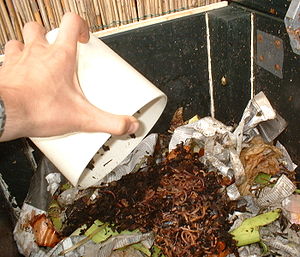| Composting-worms just added to a fresh batch of garbage in a self-made worm-bin. (Photo credit: Wikipedia) |
Not all worms are good for a home composting set-up. In fact, some types of worms can't be used for any type of composting system. However, a handful of worm varieties do make great organic composting partners. They include:
* Red wigglers
* European night crawlers
* Belgian night crawlers
* Blueworms
Of all of these types of earthworms, the red wigglers are the most common worms used in vermiculture. All worm types can be found in your local nursery, live bait shop, and of course ordered online - because who doesn’t want to receive a box of worms in their mailbox! :-)
What Do Worms Eat?
Not everything can be composted. However, vermiculture does lend itself to more options than standard composting. Worms can eat:
* Fruit and their peels
* Vegetables and their peels
* Pulverized egg shells
* Tea bags
* Coffee grounds
They can also eat meat and dairy products, oily foods, and grains. However, these items tend to smell something awful and most people don’t recommend composting them.
Materials To Compost With Worms At Home
| The inside of a worm composting bin, after the worms have eaten many kitchen scraps. Note the castings on the sides of the bin. (Photo credit: Wikipedia) |
* A bin – a wash bin or commercial worm bin are both great options. It doesn’t need to be deep because the worms like to hang out near the surface. If you’re using a wash bin, you’ll want to drill holes in the bottom for drainage. You’ll also want a cover for your bin.
* Bedding – newspaper works the best because it’s easy to access. Shred it and dampen it before placing it in your bin. Add a few handfuls of soil and you’re ready to add the wigglers.
* Worms
* Food to compost – the ratio is one pound of food waste per day to two pounds of worms. If you have fewer worms, reduce the food waste accordingly.
Place your worm bin in a room with moderate temperatures that is easy enough to access. Options might include your kitchen, basement, outside the back door or in your laundry room. When your compost is ready, it will resemble a dark, rich soil. You can use it in your garden or place around houseplants.
Be sure to check back Thursday when we will share some tips for making sure your worm composting venture is a success! Or check out the very helpful book Worms Eat My Garbage: How to Set Up and Maintain a Worm Composting System.



No comments:
Post a Comment